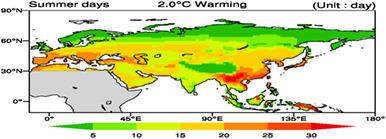当前位置:
X-MOL 学术
›
Int. J. Climatol.
›
论文详情
Our official English website, www.x-mol.net, welcomes your
feedback! (Note: you will need to create a separate account there.)
Extreme temperature indices in Eurasia in a CMIP6 multi-model ensemble: Evaluation and projection
International Journal of Climatology ( IF 3.5 ) Pub Date : 2021-04-10 , DOI: 10.1002/joc.7134 Yimin Zhao 1, 2 , Cheng Qian 2, 3 , Wenjun Zhang 1 , Dong He 4 , Yajie Qi 5
International Journal of Climatology ( IF 3.5 ) Pub Date : 2021-04-10 , DOI: 10.1002/joc.7134 Yimin Zhao 1, 2 , Cheng Qian 2, 3 , Wenjun Zhang 1 , Dong He 4 , Yajie Qi 5
Affiliation

|
It is important to project the changes in extreme temperature in Eurasia, where more than two-thirds of the world's population reside. Employing Phase 6 of the Coupled Model Intercomparison Project (CMIP6) simulations and extreme temperature indices defined by the expert team on climate change detection and Indices, we firstly evaluate the performance of the CMIP6 models, and then project the spatial patterns of changes in extreme temperature in different periods under shared social-economic Pathway scenarios and at different global warming levels. The results show that the performance of the CMIP6 models in simulating the indices of the coldest day (TXn), the coldest night (TNn), summer days (SU), tropical nights (TR) and frost days (FD) are good. Therefore, these five indices were selected for projection. Overall, TXn, TNn, SU and TR show an increasing trend and FD a decreasing trend, consistent with global warming in the future. The responses to global warming tend to be strongest in high latitudes for TXn and TNn, in high latitudes and high-altitude areas for FD, and in some low-latitude areas for SU and TR. At the local scale over Eurasia, where the change is larger than the regional median level, the changes in extreme temperature indices at 1.5°C of global warming above pre-industrial levels are projected to be reduced by 30–55% and 55–85%, respectively, compared with the situation at 2.0°C and 3.0 warming. If global warming could be controlled to within 2.0°C, the changes in extreme temperature indices over Eurasia would be reduced by up to 60% compared with the situation at 3.0°C warming. Therefore, if global warming can be controlled to within a low warming target, the risk of extreme temperature change will be greatly reduced in these regions.
中文翻译:

CMIP6 多模式集合中欧亚大陆的极端温度指数:评估和预测
预测欧亚大陆极端温度的变化非常重要,欧亚大陆居住着世界三分之二以上的人口。利用耦合模型比对项目(CMIP6)的第六阶段模拟和气候变化检测和指数专家组定义的极端温度指数,我们首先评估CMIP6模型的性能,然后预测极端温度变化的空间模式在共享的社会经济路径情景和不同全球变暖水平下的不同时期。结果表明,CMIP6模型在模拟最冷日(TXn)、最冷夜(TNn)、夏季日(SU)、热带夜(TR)和霜日(FD)等指标方面表现良好。因此,选择这五个指标进行预测。总体而言,TXn、TNn、SU和TR呈上升趋势,FD呈下降趋势,与未来全球变暖一致。TXn和TNn在高纬度地区对全球变暖的反应往往最强,FD在高纬度和高海拔地区,SU和TR在一些低纬度地区。在欧亚大陆的局部尺度上,变化大于区域中值水平,全球变暖超过工业化前水平 1.5°C 时极端温度指数的变化预计将减少 30-55% 和 55-85 %,分别与升温 2.0°C 和升温 3.0 时的情况相比。如果全球变暖能够控制在2.0°C以内,欧亚大陆极端温度指数的变化将比升温3.0°C的情况减少多达60%。所以,
更新日期:2021-04-10
中文翻译:

CMIP6 多模式集合中欧亚大陆的极端温度指数:评估和预测
预测欧亚大陆极端温度的变化非常重要,欧亚大陆居住着世界三分之二以上的人口。利用耦合模型比对项目(CMIP6)的第六阶段模拟和气候变化检测和指数专家组定义的极端温度指数,我们首先评估CMIP6模型的性能,然后预测极端温度变化的空间模式在共享的社会经济路径情景和不同全球变暖水平下的不同时期。结果表明,CMIP6模型在模拟最冷日(TXn)、最冷夜(TNn)、夏季日(SU)、热带夜(TR)和霜日(FD)等指标方面表现良好。因此,选择这五个指标进行预测。总体而言,TXn、TNn、SU和TR呈上升趋势,FD呈下降趋势,与未来全球变暖一致。TXn和TNn在高纬度地区对全球变暖的反应往往最强,FD在高纬度和高海拔地区,SU和TR在一些低纬度地区。在欧亚大陆的局部尺度上,变化大于区域中值水平,全球变暖超过工业化前水平 1.5°C 时极端温度指数的变化预计将减少 30-55% 和 55-85 %,分别与升温 2.0°C 和升温 3.0 时的情况相比。如果全球变暖能够控制在2.0°C以内,欧亚大陆极端温度指数的变化将比升温3.0°C的情况减少多达60%。所以,










































 京公网安备 11010802027423号
京公网安备 11010802027423号